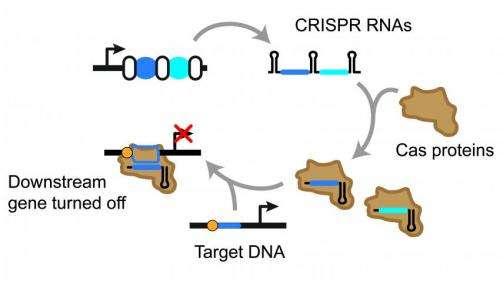Technique uses bacteria's own CRISPR-Cas system to turn off gene

Researchers from North Carolina State University have developed a technique that co-opts an immune system already present in bacteria and archaea to turn off specific genes or sets of genes – creating a powerful tool for future research on genetics and related fields.
"This should not only expedite scientific discovery, but help us better engineer microbial organisms to further biotechnology and medicine," says Dr. Chase Beisel, an assistant professor of chemical and biomolecular engineering at NC State and senior author of a paper on the work. "For example, this could help us develop bacterial strains that are more efficient at converting plant biomass into liquid fuels."
The technique works by hijacking a microbe's own CRISPR-Cas system. The system normally protects bacteria from invaders such as viruses by creating small strands of RNA called CRISPR RNAs, which match DNA sequences specific to a given invader. In the most common type of CRISPR-Cas system, called a Type I system, a CRISPR RNA and a set of proteins tightly latch onto a matching sequence of DNA. Once bound, the proteins signal for another protein called Cas3 that cuts up the DNA.
"Our approach was to modify the Type I system in two ways," Beisel says. "First we edit the microbe's genome to prevent it from producing Cas3, and then we introduce synthetic DNA that produces our customized CRISPR RNAs."
These customized RNAs include complementary sequences that are tailored to match up with specific DNA sequences in the microbe's genome.
When a gene is turned on, it transcribes specific RNAs that a cell uses to make proteins. This process is the basis of all biological functions.
But when the customized CRISPR RNAs latch onto a specific gene, those genes are turned off, or blocked from transcribing RNAs. Beisel's team was able to introduce both individual CRISPR RNAs, and groups of CRISPR RNAs that were chained together, allowing them to target multiple genes at the same time. Some of these genes enable the microbes to consume different sugars. By controlling which genes were turned off, the team could dictate which sugars the microbes could consume.
"This technique will allow researchers to better understand the role of individual genes, or sets of genes, by simply turning those genes off," Beisel says. "And this approach could be used in conjunction with high-throughput screening techniques to identify gene sets associated with problems such as multidrug resistance or benefits, like those related to probiotics."
In addition, because the affected genes aren't destroyed – there are no Cas3 proteins to chop them up – the technique can allow the genes to turn back on. This is done by halting the production of the CRISPR RNAs, which allows affected genes to begin transcribing again as the microbes reproduce and the remaining CRISPR RNA degrades.
More information: The paper, "Repurposing endogenous type I CRISPR-Cas systems for programmable gene repression," is open access and is published online in the journal Nucleic Acids Research. nar.oxfordjournals.org/content … /nar.gku971.abstract
Journal information: Nucleic Acids Research
Provided by North Carolina State University



















